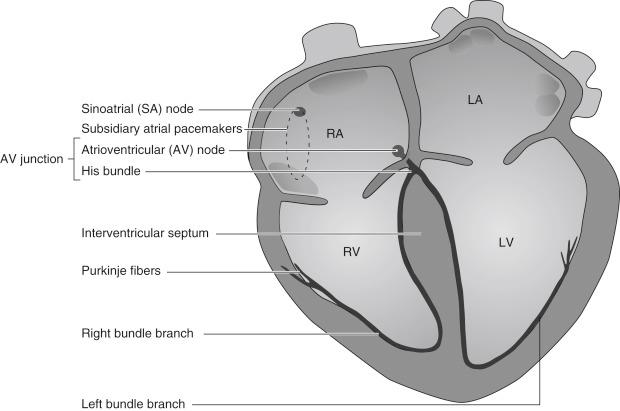Physical Address
304 North Cardinal St.
Dorchester Center, MA 02124
During an open abdominal aortic aneurysm repair, a 71-year-old man suddenly becomes profoundly hypotensive after acute blood loss. The mean arterial blood pressure is 40 mm Hg, and the electrocardiogram (ECG) shows a wide complex rhythm of 35 beats per minute. The patient’s preoperative ECG showed a first-degree heart block with a bifascicular bundle branch block pattern.
Bradyarrhythmias include cardiac rhythm abnormalities associated with a slow ventricular depolarization rate (<60 beats per minute). Such rhythm disturbances are clinically significant when associated with abnormalities of vital organ function, such as central nervous system impairment (syncope, altered mental status), postural hypotension, heart failure, or other major organ system dysfunction (especially renal, hepatic, or gastrointestinal).
Bradyarrhythmias are caused by failure of impulse formation, failure of impulse conduction, or both ( Box 133.1 ). Anatomic structures involved in the generation and propagation of electrical impulses within the heart (i.e., its specialized conduction system) are depicted in Fig. 133.1 .
Sinus bradycardia
Slow sinus node automatic rate
Sinoatrial conduction block
Carotid sinus hypersensitivity
Neurocardiogenic syncope (with decrease in sympathetic outflow)
Atrioventricular node heart block
First-degree block
Second-degree block
Type I
Type II
Third-degree block
Deep inhaled anesthetics (sevoflurane, halothane)
Sedatives (opiates, dexmedetomidine)
Regional blockade of cardiac acceleratory fibers (T1–T4)
Oculocardiac reflex
Peritoneal stimulation
Carotid body stimulation
β-Blockers, nondihydropyridine calcium channel blockers, amiodarone, digoxin
Reflex bradycardia from alpha blockade (phenylephrine)
Hypothermia
Endocrine (hypothyroidism, Addison disease)
Electrolytes (hyperkalemia, hypermagnesemia)

The maximum diastolic potential of the sinoatrial (SA) node is between −50 and −60 mV. When maximum diastolic potential is reached, SA node cells immediately begin to depolarize. Spontaneous phase 4 depolarization is due to an imbalance between slowly decaying delayed rectifier (an outward potassium current) and slowly recovering inward calcium currents. The latter cause the cell interior to become progressively less negative with respect to the exterior. A pacemaker current is involved only when the cell interior is less negative than −50 mV. In SA node cells, this current is probably subserved by L-type calcium channels. However, T-type current may be activated during the latter half of spontaneous phase 4 depolarization (i.e., normal automaticity). Cells of the SA node depolarize to +10 mV, their maximum action potential overshoot. Thus maximum amplitudes are 60 to 70 mV. Once these are reached, SA node cells repolarize. During early repolarization, especially in atrial or ventricular muscle or Purkinje fibers (i.e., “fast-response” fibers), sodium “window” and calcium currents contribute, along with several different potassium repolarizing (outward) currents. ( Note: Fast-response fibers have higher action potential maximum amplitudes and overshoots and faster rates of conduction than do SA or atrioventricular [AV] node cells. They also have more prominent early rapid [phase 1] repolarization.) Regardless, in all fiber types, net ionic movements during repolarization favor net outward movement of positive charges (mainly potassium), in addition to a variable contribution of reduced inward calcium and sodium current. During the action potential upstroke (depolarization), net ionic movements favor the net inward movement of positive charges. These are carried mainly by sodium and calcium, but there is also reduced outward movement of potassium.
The normal SA firing rate is 60 to 100 beats per minute. Drugs, neural input (both sympathetic and parasympathetic), temperature, and hormones influence the rate of sinus node depolarization by affecting either the rate of spontaneous (phase 4) depolarization or the threshold for a regenerative (self-sufficient) action potential upstroke.
In addition to sinus bradycardia (sinus rhythm with a rate less than 60 beats per minute; Fig. 133.2 ), there may be bradycardic (slow) escape rhythms arising in lower pacemakers. Such escape pacemaker rhythms (i.e., originating below the AV junction) are often associated with advanced second- and third-degree AV heart block. (Advanced second-degree AV heart block is defined as two or more successive, blocked P waves, but with some that are conducted. With third-degree [complete] AV heart block, no P waves are conducted to the ventricles.)

Become a Clinical Tree membership for Full access and enjoy Unlimited articles
If you are a member. Log in here